15世纪中国古代文化 英文
- 格式:doc
- 大小:41.00 KB
- 文档页数:2
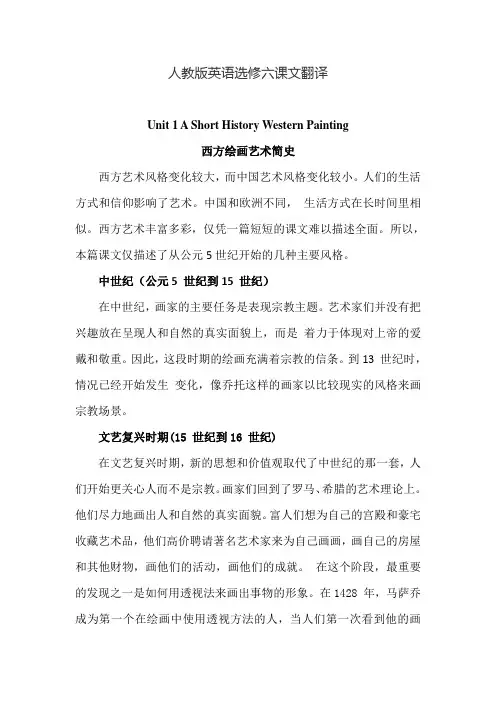
人教版英语选修六课文翻译Unit 1 A Short History Western Painting西方绘画艺术简史西方艺术风格变化较大,而中国艺术风格变化较小。
人们的生活方式和信仰影响了艺术。
中国和欧洲不同,生活方式在长时间里相似。
西方艺术丰富多彩,仅凭一篇短短的课文难以描述全面。
所以,本篇课文仅描述了从公元5世纪开始的几种主要风格。
中世纪(公元5 世纪到15 世纪)在中世纪,画家的主要任务是表现宗教主题。
艺术家们并没有把兴趣放在呈现人和自然的真实面貌上,而是着力于体现对上帝的爱戴和敬重。
因此,这段时期的绘画充满着宗教的信条。
到13 世纪时,情况已经开始发生变化,像乔托这样的画家以比较现实的风格来画宗教场景。
文艺复兴时期(15 世纪到16 世纪)在文艺复兴时期,新的思想和价值观取代了中世纪的那一套,人们开始更关心人而不是宗教。
画家们回到了罗马、希腊的艺术理论上。
他们尽力地画出人和自然的真实面貌。
富人们想为自己的宫殿和豪宅收藏艺术品,他们高价聘请著名艺术家来为自己画画,画自己的房屋和其他财物,画他们的活动,画他们的成就。
在这个阶段,最重要的发现之一是如何用透视法来画出事物的形象。
在1428 年,马萨乔成为第一个在绘画中使用透视方法的人,当人们第一次看到他的画时,还以为是透过墙上的小孔,来观看真实的情景,并对此深信不疑。
如果没有透视法,人们就不可能画出如此逼真的画,在文艺复兴时期,油画也得到了发展,它使得色彩看上去更丰富,更深沉。
印象派时期(19 世纪后期到20世纪初期)19 世纪后期,欧洲发生了巨大的变化,从以农业为主的社会变成了以工业为主的社会。
许多人从农村迁入城市。
有着大量的新发明,还有许多社会变革。
这些变革也自然而然地导致了绘画风格上的变化。
那些打破传统画法的人有在巴黎生活和工作的印象派画家。
印象派画家是第一批室外写生的艺术家。
他们想把一天中不同时间投射到物体上的光线和阴影画出来。
由于自然光的变化很快,所以,印象派画家必须很快地作画。
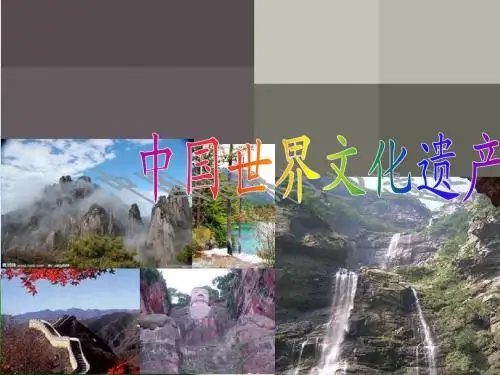
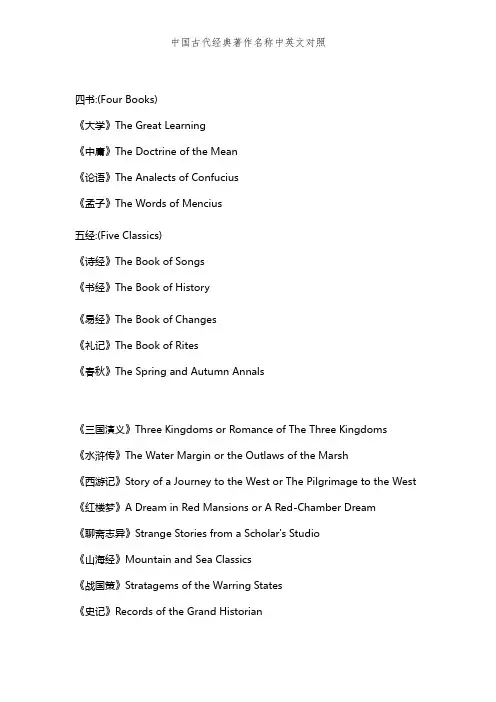
四书:(Four Books)《大学》The Great Learning《中庸》The Doctrine of the Mean《论语》The Analects of Confucius《孟子》The Words of Mencius五经:(Five Classics)《诗经》The Book of Songs《书经》The Book of History《易经》The Book of Changes《礼记》The Book of Rites《春秋》The Spring and Autumn Annals《三国演义》Three Kingdoms or Romance of The Three Kingdoms《水浒传》The Water Margin or the Outlaws of the Marsh《西游记》Story of a Journey to the West or The Pilgrimage to the West 《红楼梦》A Dream in Red Mansions or A Red-Chamber Dream《聊斋志异》Strange Stories from a Scholar's Studio《山海经》Mountain and Sea Classics《战国策》Stratagems of the Warring States《史记》Records of the Grand Historian《世纪新说》New sayings of the World《西厢记》Romance of the Western Chamber《醒世恒言》Stories to Awaken Men(觉醒者的故事)《喻世明言》Stories to Enlighten Men(开导者的故事)《警世通言》Stories to Warn Men (警告者的故事)《官场现形记》Exposure of the Official World(接触官方世界) 《本草纲目》Outline of Herb Medicine《资治通鉴》History as a Mirror(以史为镜《儒林外史》The Scholars《金瓶梅》the Golden Lotus《孙子兵法》Sun Tzu The Art Of War《道德经》Tao Te Ching《汉书》The History of the Han Dynasty《后汉书》The History of Latter Han《三国志》The History of the Three Kingdoms《二十年目睹之怪现状》Odd things witnessed over twenty years 《孽海花》A torn lily or flower in the vicious sea《老残游记》Travels of Lao Tsan or Travels of an Old Man 《孝经》Book of Filial Piety。
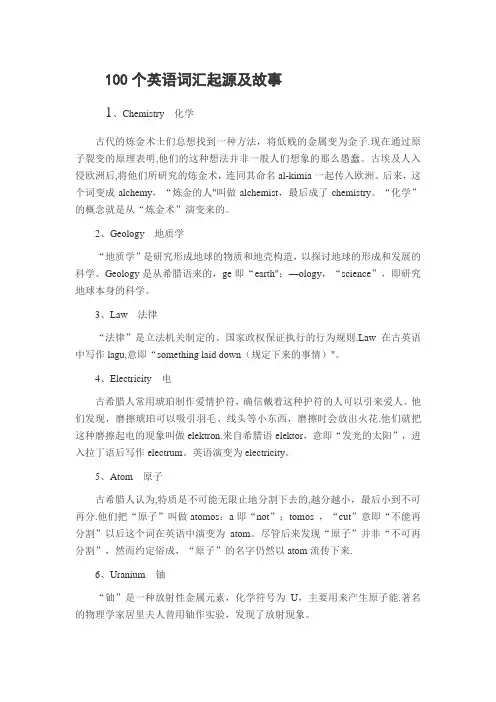
100个英语词汇起源及故事1、Chemistry 化学古代的炼金术士们总想找到一种方法,将低贱的金属变为金子.现在通过原子裂变的原理表明,他们的这种想法并非一般人们想象的那么愚蠢。
古埃及人入侵欧洲后,将他们所研究的炼金术,连同其命名al-kimia一起传入欧洲。
后来,这个词变成alchemy,“炼金的人"叫做alchemist,最后成了chemistry。
“化学”的概念就是从“炼金术”演变来的。
2、Geology 地质学“地质学”是研究形成地球的物质和地壳构造,以探讨地球的形成和发展的科学。
Geology是从希腊语来的,ge即“earth";—ology,“science”,即研究地球本身的科学。
3、Law 法律“法律”是立法机关制定的、国家政权保证执行的行为规则.Law在古英语中写作lagu,意即“something laid down(规定下来的事情)"。
4、Electricity 电古希腊人常用琥珀制作爱情护符,确信戴着这种护符的人可以引来爱人。
他们发现,磨擦琥珀可以吸引羽毛、线头等小东西,磨擦时会放出火花.他们就把这种磨擦起电的现象叫做elektron.来自希腊语elektor,意即“发光的太阳”,进入拉丁语后写作electrum。
英语演变为electricity。
5、Atom 原子古希腊人认为,特质是不可能无限止地分割下去的,越分越小,最后小到不可再分.他们把“原子”叫做atomos:a即“not”;tomos ,“cut”意即“不能再分割”以后这个词在英语中演变为atom。
尽管后来发现“原子”并非“不可再分割”,然而约定俗成,“原子”的名字仍然以atom流传下来.6、Uranium 铀“铀”是一种放射性金属元素,化学符号为U,主要用来产生原子能.著名的物理学家居里夫人曾用铀作实验,发现了放射现象。
Uranium这个词是从希腊神话中一位神的名字来的.1781年,英籍德国天文学家赫瑟尔(Sir William Herschel)发现了颗尚未被人们发现的行星,于是他就借用了希腊神话中“天王”Ouranos的名字,命名这颗行星为Uranus。
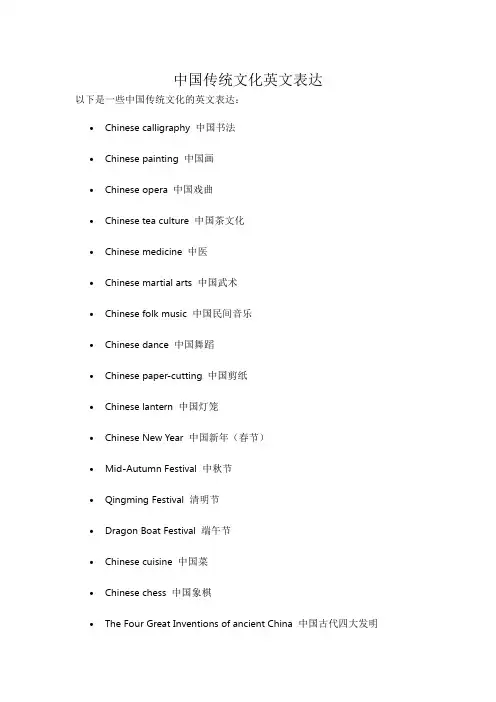
中国传统文化英文表达
以下是一些中国传统文化的英文表达:
•Chinese calligraphy 中国书法
•Chinese painting 中国画
•Chinese opera 中国戏曲
•Chinese tea culture 中国茶文化
•Chinese medicine 中医
•Chinese martial arts 中国武术
•Chinese folk music 中国民间音乐
•Chinese dance 中国舞蹈
•Chinese paper-cutting 中国剪纸
•Chinese lantern 中国灯笼
•Chinese New Year 中国新年(春节)
•Mid-Autumn Festival 中秋节
•Qingming Festival 清明节
•Dragon Boat Festival 端午节
•Chinese cuisine 中国菜
•Chinese chess 中国象棋
•The Four Great Inventions of ancient China 中国古代四大发明
这些只是中国传统文化的一部分,还有很多其他方面的文化元素,如传统服饰、建筑、文学、哲学等。
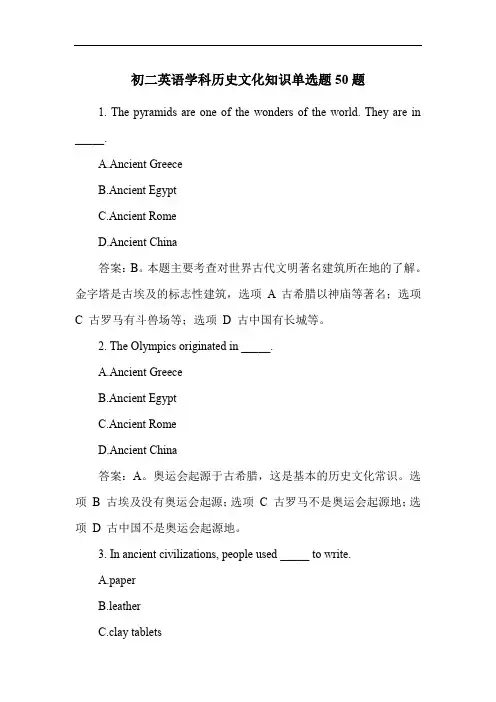
初二英语学科历史文化知识单选题50题1. The pyramids are one of the wonders of the world. They are in _____.A.Ancient GreeceB.Ancient EgyptC.Ancient RomeD.Ancient China答案:B。
本题主要考查对世界古代文明著名建筑所在地的了解。
金字塔是古埃及的标志性建筑,选项A 古希腊以神庙等著名;选项C 古罗马有斗兽场等;选项D 古中国有长城等。
2. The Olympics originated in _____.A.Ancient GreeceB.Ancient EgyptC.Ancient RomeD.Ancient China答案:A。
奥运会起源于古希腊,这是基本的历史文化常识。
选项B 古埃及没有奥运会起源;选项C 古罗马不是奥运会起源地;选项D 古中国不是奥运会起源地。
3. In ancient civilizations, people used _____ to write.A.paperB.leatherC.clay tabletsD.plastic答案:C。
在古代文明中,人们使用泥板来书写,如古埃及、古巴比伦等文明。
选项 A 纸在古代中国发明后逐渐传播,但不是所有古代文明都用纸书写;选项 B 皮革不是主要书写材料;选项 D 塑料是现代材料。
4. The Parthenon is located in _____.A.Ancient GreeceB.Ancient EgyptC.Ancient RomeD.Ancient China答案:A。
帕特农神庙位于古希腊。
选项B 古埃及没有帕特农神庙;选项 C 古罗马有其他著名建筑但不是帕特农神庙;选项 D 古中国没有帕特农神庙。
5. In ancient times, people in _____ built the Great Pyramid.A.Ancient GreeceB.Ancient EgyptC.Ancient RomeD.Ancient China答案:B。
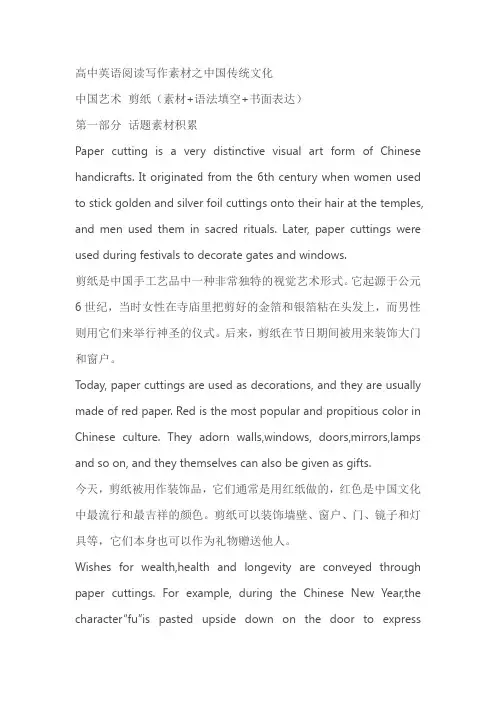
高中英语阅读写作素材之中国传统文化中国艺术剪纸(素材+语法填空+书面表达)第一部分话题素材积累Paper cutting is a very distinctive visual art form of Chinese handicrafts. It originated from the 6th century when women used to stick golden and silver foil cuttings onto their hair at the temples, and men used them in sacred rituals. Later, paper cuttings were used during festivals to decorate gates and windows.剪纸是中国手工艺品中一种非常独特的视觉艺术形式。
它起源于公元6世纪,当时女性在寺庙里把剪好的金箔和银箔粘在头发上,而男性则用它们来举行神圣的仪式。
后来,剪纸在节日期间被用来装饰大门和窗户。
Today, paper cuttings are used as decorations, and they are usually made of red paper. Red is the most popular and propitious color in Chinese culture. They adorn walls,windows, doors,mirrors,lamps and so on, and they themselves can also be given as gifts.今天,剪纸被用作装饰品,它们通常是用红纸做的,红色是中国文化中最流行和最吉祥的颜色。
剪纸可以装饰墙壁、窗户、门、镜子和灯具等,它们本身也可以作为礼物赠送他人。
Wishes for wealth,health and longevity are conveyed through paper cuttings. For example, during the Chinese New Year,the character“fu”is pasted upside down on the door to expresspeople's wish for the coming of good luck.剪纸传达了人们对财富、健康和长寿的祝愿。
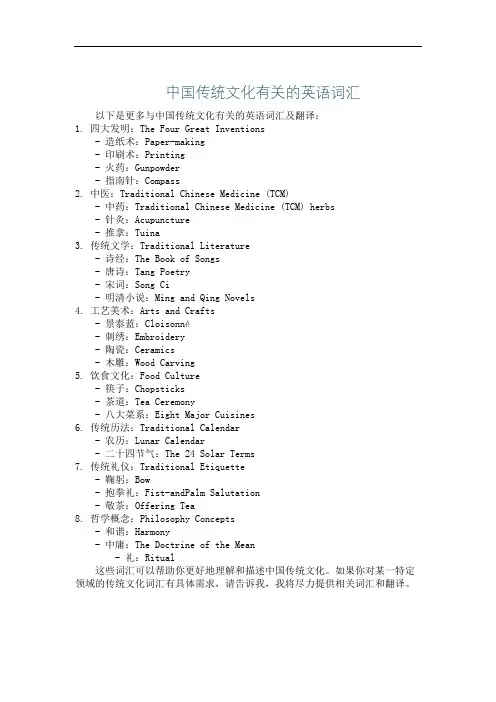
中国传统文化有关的英语词汇以下是更多与中国传统文化有关的英语词汇及翻译:1. 四大发明:The Four Great Inventions- 造纸术:Paper-making- 印刷术:Printing- 火药:Gunpowder- 指南针:Compass2. 中医:Traditional Chinese Medicine (TCM)- 中药:Traditional Chinese Medicine (TCM) herbs- 针灸:Acupuncture- 推拿:Tuina3. 传统文学:Traditional Literature- 诗经:The Book of Songs- 唐诗:Tang Poetry- 宋词:Song Ci- 明清小说:Ming and Qing Novels4. 工艺美术:Arts and Crafts- 景泰蓝:Cloisonné- 刺绣:Embroidery- 陶瓷:Ceramics- 木雕:Wood Carving5. 饮食文化:Food Culture- 筷子:Chopsticks- 茶道:Tea Ceremony- 八大菜系:Eight Major Cuisines6. 传统历法:Traditional Calendar- 农历:Lunar Calendar- 二十四节气:The 24 Solar Terms7. 传统礼仪:Traditional Etiquette- 鞠躬:Bow- 抱拳礼:Fist-andPalm Salutation- 敬茶:Offering Tea8. 哲学概念:Philosophy Concepts- 和谐:Harmony- 中庸:The Doctrine of the Mean- 礼:Ritual这些词汇可以帮助你更好地理解和描述中国传统文化。
如果你对某一特定领域的传统文化词汇有具体需求,请告诉我,我将尽力提供相关词汇和翻译。
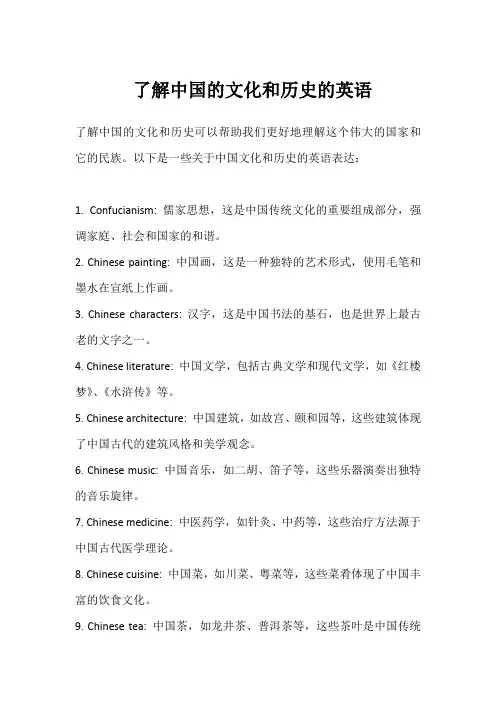
了解中国的文化和历史的英语
了解中国的文化和历史可以帮助我们更好地理解这个伟大的国家和它的民族。
以下是一些关于中国文化和历史的英语表达:
1. Confucianism: 儒家思想,这是中国传统文化的重要组成部分,强调家庭、社会和国家的和谐。
2. Chinese painting: 中国画,这是一种独特的艺术形式,使用毛笔和墨水在宣纸上作画。
3. Chinese characters: 汉字,这是中国书法的基石,也是世界上最古老的文字之一。
4. Chinese literature: 中国文学,包括古典文学和现代文学,如《红楼梦》、《水浒传》等。
5. Chinese architecture: 中国建筑,如故宫、颐和园等,这些建筑体现了中国古代的建筑风格和美学观念。
6. Chinese music: 中国音乐,如二胡、笛子等,这些乐器演奏出独特的音乐旋律。
7. Chinese medicine: 中医药学,如针灸、中药等,这些治疗方法源于中国古代医学理论。
8. Chinese cuisine: 中国菜,如川菜、粤菜等,这些菜肴体现了中国丰富的饮食文化。
9. Chinese tea: 中国茶,如龙井茶、普洱茶等,这些茶叶是中国传统
文化的重要组成部分。
10. Chinese history: 中国历史,从古代到现代,经历了数千年的发展历程。
了解中国的文化和历史需要长期的积累和学习。
希望这些英语表达可以帮助你更好地了解这个伟大的国家。

英语作文四大发明15句简单英文回答:The Four Great Inventions of Ancient China.Ancient China was a hub of innovation and technological advancement. Among the countless inventions that originated in China, four stand out as the most significant and influential: papermaking, printing, gunpowder, and the compass. These inventions had a profound impact on Chinese society and culture, and their influence spread far beyond the borders of China, shaping the course of world history.1. Papermaking.Papermaking is considered one of the most important inventions of all time. Before paper, people wrote on materials such as bamboo, wood, and silk, which were expensive and difficult to work with. The invention of paper in the 1st century CE revolutionized writing andcommunication, making it easier and more affordable to produce books, documents, and other written works.2. Printing.The invention of printing in the 9th century CE was another major breakthrough. Before printing, books and other printed materials were produced by hand, a slow and labor-intensive process. The invention of the printing press made it possible to produce large quantities of printed materials quickly and cheaply, making knowledge more accessible to the general public.3. Gunpowder.Gunpowder, invented in the 9th century CE, had a significant impact on warfare and military technology. Before gunpowder, armies relied on weapons such as swords, spears, and bows and arrows. The invention of gunpowder led to the development of firearms, which gave armies a new level of firepower and destructive power.4. Compass.The compass, invented in the 11th century CE, played a crucial role in navigation and exploration. Before the compass, sailors relied on the stars and the sun to navigate, which was often difficult and unreliable. The invention of the compass allowed sailors to determine their direction more accurately, making long-distance travel and exploration possible.The Four Great Inventions of Ancient China were not only technological marvels but also catalysts for social, cultural, and economic change. They transformed the way people communicated, learned, waged war, and explored the world. Their legacy continues to shape our lives today, and they stand as a testament to the ingenuity and innovation of ancient Chinese inventors.中文回答:中国古代四大发明。
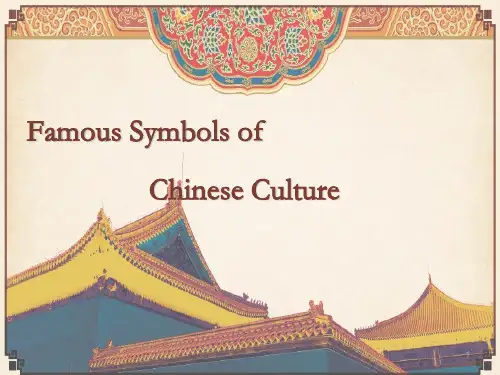
介绍中国景点英语作文英文回答:China is a vast and diverse country with a richcultural heritage and stunning natural beauty. From the towering peaks of the Himalayas to the tranquil waters ofthe Yangtze River, there is something for everyone to enjoy.1. The Great Wall of China。
The Great Wall of China is one of the most iconic landmarks in the world. It is a UNESCO World Heritage Site and one of the Seven Wonders of the Modern World. The wall was built over centuries to protect China from invaders,and it is an incredible feat of engineering. You can walk along the wall, climb watchtowers, and enjoy stunning views of the surrounding countryside.2. The Forbidden City。
The Forbidden City is a former imperial palace locatedin the heart of Beijing. It was built in the 15th century and was home to the Ming and Qing emperors. The Forbidden City is a vast complex with over 9,000 rooms, and it is now a museum that houses a vast collection of Chinese art and artifacts.3. The Terracotta Army。
造纸术的历史、发展及影响英语作文英文回答:History and Development of Papermaking.Papermaking, an ancient craft with profound cultural and technological significance, traces its roots back thousands of years. The earliest known paper, produced in China around 105 AD by the eunuch Cai Lun, was crafted from macerated plant fibers. This groundbreaking invention revolutionized communication and record-keeping, enabling the spread of knowledge and literacy throughout the world.Over the centuries, papermaking techniques spread westward, reaching Europe in the 11th century and the Middle East shortly thereafter. In the 15th century, the invention of the printing press by Johannes Gutenberg ushered in a new era of information dissemination, making paper an indispensable medium for preserving and sharing ideas.In the 19th century, the industrial revolution transformed papermaking from a labor-intensive craft to a mechanized industry. The invention of the paper machine by the Fourdrinier brothers in 1803 enabled continuous production of paper rolls, significantly increasing efficiency and lowering costs.Impact of Papermaking.The invention of paper had a profound impact on human civilization, shaping the course of history in multiple ways.Communication and Literacy: Paper facilitated the spread of written knowledge and ideas across vast distances, enabling the exchange of information, the preservation of cultural heritage, and the emergence of a literate society.Education and Science: Paper became an essential tool for education, facilitating the dissemination of scientific discoveries, the development of knowledge, and the spreadof literacy throughout society.Administration and Government: Paper played a crucial role in the development of administration and government, enabling the recording of laws, regulations, and historical events, and facilitating the efficient flow of information within bureaucratic systems.Commerce and Trade: Paper made possible the creation of contracts, invoices, and other commercial documents, facilitating the expansion of trade and commerce and the establishment of a global economy.Arts and Culture: Paper became a medium for artistic expression, leading to the development of painting, calligraphy, and printing techniques, and enrichingcultural traditions around the world.Conclusion.The invention of paper was a major turning point in human history, transforming communication, education,administration, commerce, and the arts. From its humble beginnings in ancient China to its widespread use today, paper has played an indispensable role in preserving and transmitting knowledge, facilitating innovation, andshaping the course of civilization.中文回答:造纸术的历史、发展和影响。
故宫导游词英文带翻译Let me introduce you to the Palace Museum, also known as the Forbidden City. The Forbidden City is the largest and most well-preserved imperial palace complex in the world. Its history can be traced back to the early 15th century when it was built during the Ming dynasty.让我向您介绍故宫博物院,也被称为紫禁城。
紫禁城是世界上最大、保存最完好的皇宫建筑群。
其历史可以追溯到15世纪初明朝时期的建造。
The Forbidden City consists of two main parts: the Outer Court for ceremonies and the Inner Court for residence. The architecture of the Forbidden City is a masterpiece of ancient Chinese architecture with its red walls, golden roofs, and numerous halls, pavilions, and gardens.紫禁城主要由两部分组成:外朝和内廷。
外朝是举行宴会及其他重要活动的地方,内廷是皇帝及其家族居住及办公的地方。
紫禁城建筑是古代中国建筑的杰作,其红色的围墙、金色的屋顶,以及众多的殿堂、亭台和园林都是不可错过的。
As we visit each hall, you will learn about the historical significance of each one, the treasures it holds, and the stories behind them. You will see collections of fine art, ancient books, jade carvings, and many other cultural relics.在我们参观每个殿堂时,您将了解到每个殿堂的历史意义、珍宝以及其中的故事。
古英语和中古英语时期古英语时期是指英国国家和英语语言的形成时期.最早的文学形式是诗歌, 以口头形式流传,主要的诗人是吟游诗人.到基督教传入英国之后,一些诗歌才被记录下来.这一时期最重要的文学作品是英国的民族史诗《贝奥武夫》,用头韵体写成.古英语时期(1066?1500)从1066年诺曼人征服英国,到1500年前后伦敦方言发展成为公认的现代英语.文学作品主要的形式有骑士传奇,民谣和诗歌.在几组骑士传奇中,有关英国题材的是亚瑟王和他的圆桌骑士的冒险故事,其中《高文爵士和绿衣骑士》代表了骑士传奇的最高成就.中世纪文学中涌现了大量的优秀民谣,最具代表性的是收录在一起的唱咏绿林英雄罗宾汉的民谣.3,最重要的诗人是被称为"英国诗歌之父"的乔叟,代表作是《坎特伯雷故事集》,取得了很高的艺术成就.他首创了诗歌的双韵体?每两行压韵的五步抑扬格,后被许多英国诗人采用.乔叟用伦敦方言写作,奠定了用英语语言进行文学创作的基础,促进了英语语言文学的发展.文艺复兴时期的英国文学得到了空前的发展,在诗歌,散文和戏剧方面尤其兴盛.诗歌方面,新的诗体形式如十四行诗,无韵体诗被介绍到英国.重要的诗人有Philip Sidney,他不仅写了许多优美的十四行诗,还创作了最早的诗歌理论作品之一《诗辩》.Edmund Spenser 用斯宾塞诗节创作了著名长诗《仙后》.莎士比亚除了戏剧创作之外也是一位伟大诗人,著有两部叙事诗,两部长诗和154首十四行诗.英文的《圣经钦定本》作成于1611年,不仅具有重大的宗教意义,也是一部伟大的文学作品,并且对英国的语言文化产生了深远的影响.它的纯朴,平易,明晰的散文风格奠定了英国散文的传统.一个著名的哲学家兼散文家是Francis Bacon,他的文学著作主要有《随笔》,收录了他在各个时期发表的58篇随笔,思想深刻,文笔简洁,富有警句格言.戏剧代表文艺复兴时期英国文学的最高成就.主要戏剧家有马洛(Christopher Marlowe), 莎士比亚(W. Shakespeare).17世纪的英国文学17世纪是英国社会剧烈动荡的时期之一,由于君主专制和资产阶级之间的矛盾,爆发了1642年的内战并导致了1688年的"光荣革命".与政治斗争和资产阶级革命思想紧密相连的是宗教斗争和清教徒思想.因此这一时期的文学和艺术多展示革命思想的发展与成长,并带有浓厚的清教主义倾向.两个代表作家是弥尔顿和班扬.弥尔顿的代表作〈失乐园〉和班扬的代表作〈天路历程〉都取材于〈圣经〉.〈天路历程〉是一部寓言作品,用"基督徒"到达天国的历程象征人类追求美好未来的进程.18世纪的英国文学18世纪产生了一种进步思潮?启蒙运动,这一时期的思想家和作家们崇尚理性,认为启蒙教化是改造社会的基本手段,因此18世纪又被称为"理性的时代".在文学领域体现为18世纪上半期的新古典主义,代表作家有诗人蒲伯(A. Pope)和期刊随笔的创始人斯梯尔(R.Steele)和艾迪生(J.Addison).18中期兴起了英国现代小说,出现了大批有影响的小说家.理查逊(Samuel Richardson)的小说〈帕美拉〉(Pamela)采用书信体形式对人物的心理活动进行细致的描写,大大丰富了小说的创作方法.哥尔德史密斯(Oliver Goldsmith)的〈威克菲牧师传〉(The Vicar of Wakefield)是英国文学史上著名的感伤小说之一.劳伦斯斯特恩(Laurence Sterne)打破传统的叙事方法,创作了〈项迪传〉,而被认为是英国现代派文学的先驱.迪福(Daniel Defoe)是英国文学史上第一个现实主义小说家,代表作是〈鲁滨逊漂流记〉.讲述故事情节并分析鲁滨逊这一人物形象.斯威夫特是英国文学史上著名的讽刺小说家,以犀利的文笔对教会和社会的虚伪腐败进行了辛辣的讽刺.代表作是〈格列佛游记〉菲尔丁是英国最杰出的小说家之一,在理论与实践上都为英国小说的发展作出了贡献.在他的代表作〈汤姆?琼斯〉中,他塑造了众多栩栩如生的人物,展示了错综复杂的社会矛盾.讲述故事情节,分析主题和主要人物形象19世纪的英国文学19世纪英国文学主要包括上半期的浪漫主义时期和中后期的批判现实主义小说.布来克和罗伯特?彭斯属于前浪漫主义诗人.布来克的代表作品有〈天真之歌〉和〈经验之歌〉.彭斯是著名的苏格兰民族诗人,写了很多脍炙人口的歌颂友谊,爱情,自由,平等的诗歌,其中〈一朵红红的玫瑰〉广为流传.浪漫主义全盛时期以华滋华斯与柯律维治联合发表〈抒情歌谣集〉为开始,到瓦尔特斯各特的逝世为止,主要文学成就为诗歌,涌现了华滋华斯为代表的"湖畔派"诗人和拜伦,雪莱,济慈等富有革命理想,颂扬自由与解放的诗人.19世纪中后期的批判现实主义作家真实地描写了英国资产阶级的社会生活,暴露和批判了资产阶级社会的罪恶,对人民群众寄予了深刻的同情.狄更斯是英国最杰出的批判现实主义小说家,善于描写社会底层人们的生活和思想,作品题材广泛,思想深刻;萨克雷则善于描写上层社会形形色色的人物.批判现实主义女性小说家及她们的代表作品:Charlotte Bronte, Emily Bronte, Mrs. Gaskell, George Eliot.分析简?爱这一人物形象并分析小说的主题思想.托马斯?哈代是19世纪末20世纪初英国最伟大的现实主义小说家,他称自己的作品是"性格与环境的小说".代表作品是〈德伯家的苔丝〉.20世纪的现代派作家人们对西方文明的危机感和第二次世界大战的恶果促成了西方现代派文学的形成.主要表现为意识流小说,代表作家有詹姆斯乔伊斯和弗洁尼亚沃尔夫.乔伊斯的小说〈尤利西斯〉描写的是现代都市居民庸俗,猥琐的精神生活.弗洁尼亚的〈到灯塔去〉则运用了娴熟的象征手法和意识流技巧.英国文学英国文学源远流长,经历了长期、复杂的发展演变过程。
1中文:风筝,古时候也叫纸鸢(Zhiyuan),是中国人发明的。
相传两千多年前中国著名的工匠鲁班用竹木制成了会飞的木鹊(bamboo magpie)。
放风筝是一项有益于身体健康的体育活动,所以,世界上许多国家十分流行放风筝。
中国人不仅把放风筝当作有趣的游戏和有益于身体健康的体育活动,也常常把风筝挂在墙壁上作为装饰。
目前,中国的风筝已经远销到日本以及东南亚和欧美的许多国家,受到了世界各国人民的欢迎。
语言要点:carpenter; flying kites; be beneficial to; decoration; gain great popularity译文:Kite also known as Zhiyuan in ancient China was invented by the Chinese people. It is said that Lu Ban a well-known carpenter made a bamboo magpie that could fly. As flying kites is beneficial to one’s health it is h ighly popular in many countries of the world. The Chinese regard it as an interesting game as well as a healthful sport. Some people hang kites on the wall for decoration. Chinese kites are now exported to Japan Southeast Asia and many countries in Europe and America. They gain great popularity among people around the world.2中文:清明节(The Qingming Festival)是人们纪念逝去亲人的日子。
中国非物质文化遗产:中国珠算Have you ever wondered how you would you solve math problems if you didn’t have a calculator or computer or even pencil and paper? For centuries, people in Asia have used an ancient counting tool to perform mathematical operations. The Chinese calculator name is “suanpan,” but it is also known as an abacus. Dating back to at least the 12th century, this simple counting device has been passed down through the centuries with its original design and purpose virtually unchanged.你有没有想过如果你没有计算器或电脑,甚至没有铅笔和纸,你会如何解决数学问题?几个世纪以来,亚洲人一直使用古老的计数工具来进行数学运算。
中国计算器的名字是“算盘”,但它也被称为珠算。
这种简单的计数装置至少可以追溯到12世纪,几个世纪以来一直沿用至今,其原始设计和用途几乎没有改变。
Considered one of the first mathematical instruments, the abacus has evolved significantly and so have the ways to use them. This Chinese Abacus also known as a Suan Pan has a 5+2 bead combination, with 5 earth beads and 2 heaven beads on a single rod split by a wooden barrier. The number of rods indicates the degree of accuracy of the calculated number for example 3 rods indicates a 3 digit number either 100, 010=10or 001 as 0.01. The choice of decimal point was dependent on the use.算盘被认为是最早的数学工具之一,已经有了很大的发展,使用算盘的方法也有了很大的进步。
15世纪末以前,从西方通往东方的商路主要有三条。
一条是陆路,即传统的“丝绸之路”,从君士坦丁堡登陆,经小亚细亚、黑海和里海南岸至中亚,再翻越帕米尔高原到中国。
另两条是海路:一条从叙利亚和地中海东岸,经两河流域到波斯湾,另一条从埃及经红海至波斯湾,再换船到印度和中国。
这几条商路本来就经过意大利、阿拉伯、拜占廷和波斯等地的商人多次转手,才能将货物运抵西欧。
当时西欧造船术的进步、地理知识的积累、地圆说的传布、以及由中国传入的罗盘的运用,都为欧洲人从事远航提供了条件。
自古以来东西方的商业联系都是比较密切的。
“丝绸之路”把东方的商品如丝绸、瓷器、香料、棉、麻、蓝靛、宝石、金、银以及一些稀有药材等输往欧洲,同时也把欧洲的呢绒等商品输往东方。
11~13世纪十字军东侵以后,东西方的交往和经济交流有了进一步的发展。
15世纪中叶以后,地中海东部的商路,以及经埃及出红海通往印度洋的航路,分别被土耳其人和阿拉伯人所控制,地中海区域的中介贸易受到阻滞。
于是西欧各国的商人、航海家和探险家都急于探寻一条不经地中海东部地区而直达东方的航线。
入印度洋,占据印度西海岸贸易重镇果阿(Goa),以及东西洋交通咽喉马六甲(Malacca),来到大明帝国的东南沿海。
西班牙人哥伦布发现美洲“新大陆”,后来绕过美洲南端进入太平洋,到达菲律宾群岛以及中国沿海。
这两个国家的商人都把与中国贸易当作首要任务,或者说作为牟取巨额利润的重要渠道。
与此同时,大明帝国永乐时期“海上丝绸之路”的开通,就使大明帝国进入了全球贸易的体系之中。
大帆船贸易自1565年开始,1815年结束,每两年往返一次。
这种贸易实际上就是用美洲的金银换取亚洲尤其是中国的产品。
大帆船载着亚洲的商品到墨西哥去,再从阿卡普尔科把这些亚洲特产用大轮车运往其他地方,部分货物甚至转运到危地马拉、厄瓜多尔、秘鲁、智利和阿根廷。
在回程中,这些大帆船运回墨西哥产的银元、银锭、可可子、羊毛等土特产。
由于亚洲产品价廉物美,在美洲曾一度排挤了西班牙。
历时250余年的大帆船贸易促进了太平洋两岸的经济文化交流,通过贸易,美洲的玉蜀黍、烟草、花生、西红柿等作物传入中国和亚洲。
东方文化特别是中国的工艺美术对美洲文化产生了一定的影响。
从经济上看,马尼拉是17世纪下述两大重要经济活动的交汇点:一个是西属美洲银矿出产的白银大量流入,另一个是华人们的门类齐全的制造业的商业企业。
无论是哪一年,都会有一两艘西班牙大帆船,从阿卡普尔科穿越太平洋,把“新世界”出产的白银运到马尼拉,以购买中国丝绸、中国和印度的棉织品,以及“新世界”需求量甚大的其他精美消费品。
基于经济上的考量,他们不得不利用华人擅于经商的长处,为他们提供日常用品,也牟取庞大的利益。
明朝丝绸不仅泛滥于美洲市场,夺取了西班牙丝绸在美洲的销路,甚至绕过大半个地球,远销西班牙本土,在那里直接破坏西班牙的丝绸生产。
“马尼拉大帆船”造成的经济和金融后果是,大明帝国凭借着在丝绸、瓷器等方面无与匹敌的制造业和出口,与任何国家进行贸易都是顺差。
因此,正如印度总是短缺白银,明朝则是最重要的白银净进口国,用进口美洲白银来满足它的通货需求。
美洲白银或者通过欧洲、西亚、印度、东南亚输入中国,或者用从阿卡普尔科出发的马尼拉大帆船直接运往中国
因此史家评论说,马尼拉不过是中国与美洲之间海上丝绸之路的中转站,“马尼拉大帆船”严格说来是运输中国货的大帆船。
美国历史学家苏尔兹(WilliamLytleSchurz)在《马尼拉大帆船》(TheManilaGalleon)中指出:“中国往往是大帆船贸易货物的主要来源,就新西班牙(墨西哥及其附近广大地区)的人民来说,大帆船就是中国船,马尼拉就是中国与墨西哥之间的转运站,作为大帆船贸易的最重要商品的中国丝货,都以它为集散地而横渡太平洋。
在墨西哥的西班牙人,当无拘无束地谈论菲律宾的时候,有如谈及中华帝国的一个省那样。
”
当时大明帝国出口的商品都是以生丝、丝绸、棉布为主,而进口的只有少量的香料之类,葡萄牙、西班牙始终处于贸易逆差之中,中国则始终处于贸易顺差之中。
贸易的不平衡,导致对方不得不支付巨额的白银货币。
因此这种贸易被外国
学者称为“丝—银对流”或“丝—银贸易”。
这种状况也延续到了后来的清朝,持续了近两个半世纪,美洲的白银与日本的白银大量流入中国,成为当时全球化贸易中一道独特的风景。
中国在对外贸易中长期处于结构性顺差之中,反映了当时中国的经济优势。
前几年曾经轰动一时的美国学者弗兰克的著作——《白银资本——重视经济全球化中的东方》,研究1500~1800年间的全球经济,把欧洲国家在与中国的贸易存在的结构性贸易逆差,戏称为“商业上的…纳贡‟”。
他写道:“…中国贸易‟造成的经济和金融后果是,中国凭借在丝绸、瓷器等方面无与匹敌的制造业和出口,与任何国家进行贸易都是顺差”;“外国人,包括欧洲人,为了与中国人做生意,不得不向中国人支付白银,这也确实表现为商业上的…纳贡‟”。
弗兰克由此得出结论:1500年至1800年,“经济全球化中的东方”是世界经济的中心,换句话说,在欧洲工业革命之前,世界的经济中心不在欧洲,而在亚洲,特别是中国。
此言一出,引起西方学者极大的争议。
当时的经济中心究竟在哪里,可以讨论。
但是中国经济曾经有过的辉煌,却是不争的事实。
个中缘由,全汉升在《略论新航路发现后的海上丝绸之路》中说得很明白了:“在近代工业化成功以前,中国工业的发展,就其使中国产品在国际市场上具有强大的竞争力来说,显然曾经有过一页光荣的历史。
大约在1530年以前,西班牙美洲殖民地已有丝织业。
自从马尼拉大帆船运来了质量精美、价格低廉的中国生丝和绸缎,当地的丝织业就此趋于衰落。
1600年,西班牙当局对当地的养蚕户加以限制,断绝了本地蚕丝的供应,由源源不断输入的中国生丝为墨西哥工厂提供原料。
1637年,墨西哥一处一家以中国生丝为原料的丝织厂的工人达到14000人,中国生丝销售数量之大由此可见一斑。
这种情况是汉唐时代的丝绸之路不可同日而语的,马尼拉大帆船的运输量,是那种穿越沙漠地带的骆驼商队无法比拟的。
法国年鉴派历史学家布罗代尔的名著《15至18世纪的物质文明、经济和资本主义》,把马尼拉大帆船作为近代意义的跨越洲际的远程贸易,纳入全球经济的视野来考察。
他说,16世纪,各种因素协力促成的运动,是从中国前往美洲,马尼拉大帆船代表着一条特殊的流通路线,这是一种资本巨大的远程贸易,形成了跨越太平洋的“丝-银”对流。